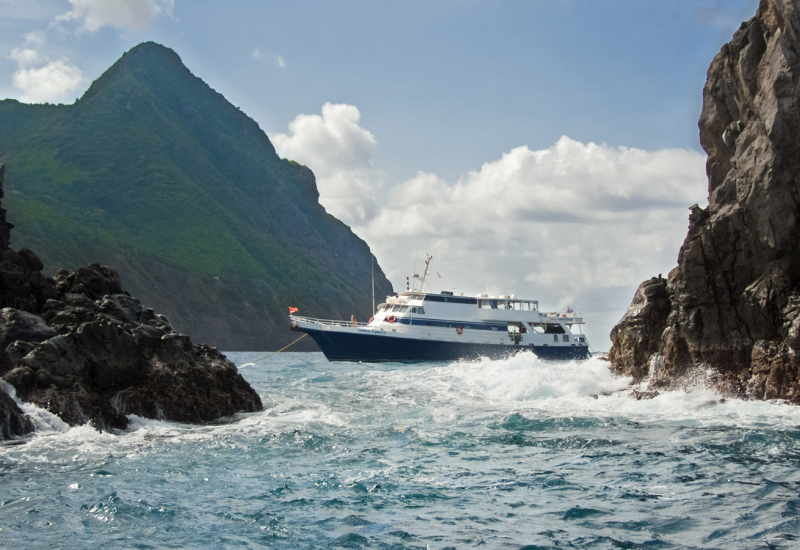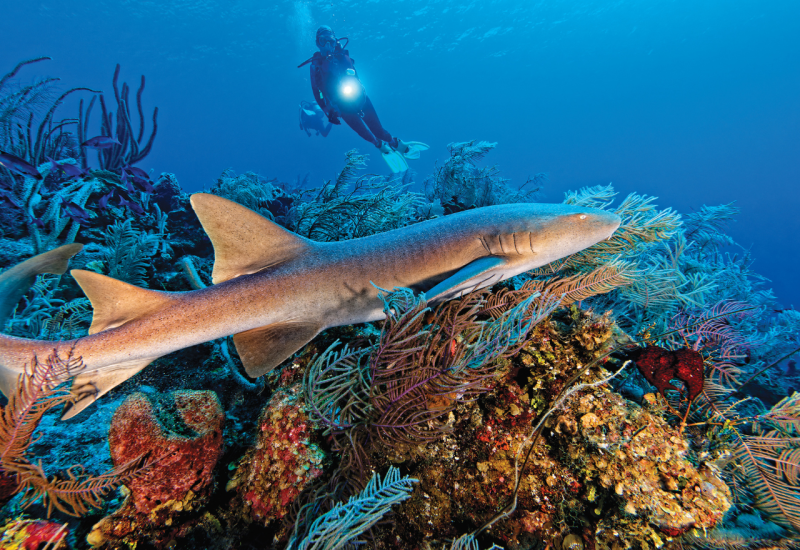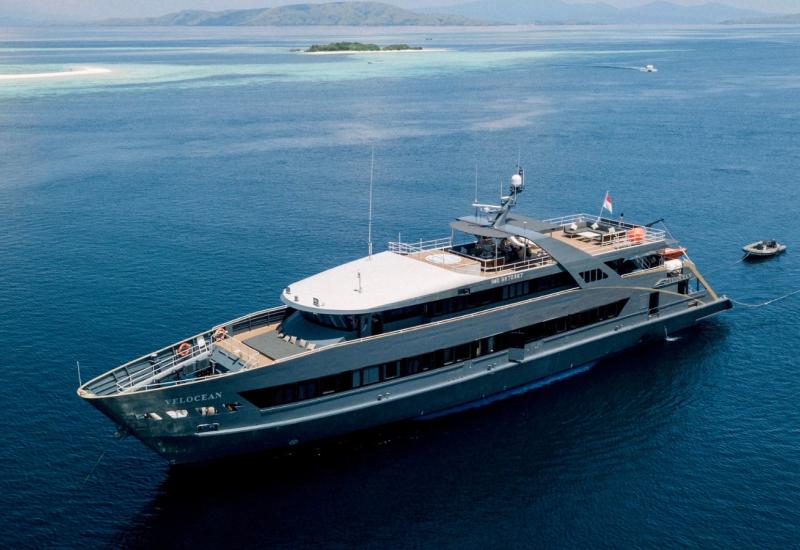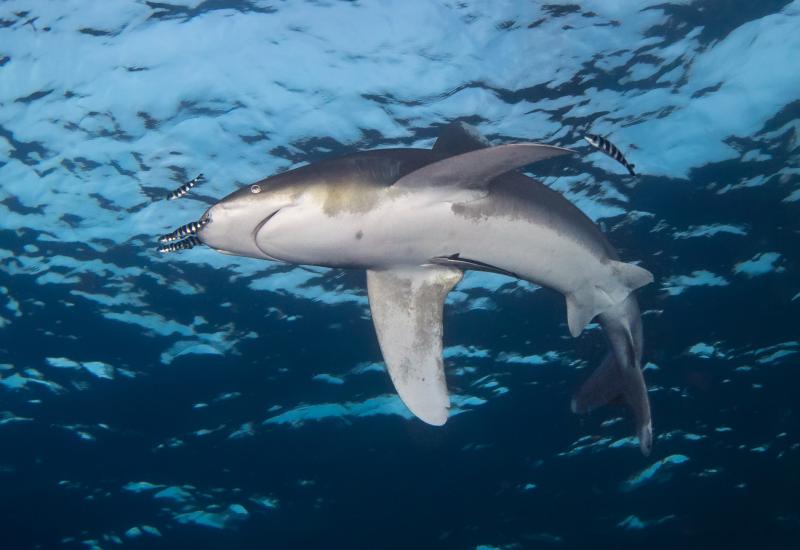Kona Aggressor II Liveaboard: Where the Whales Are
The excitement is palpable when we come aboard, from the crew as much as the guests. Everywhere around us, as soon as we leave the wharf at Kailua-Kona Village, are humpback whales.
It’s mid-February on the Kona Aggressor II, sailing the sheltered western side of the Big Island of Hawaii. This is the time of year when whales come here to calve and mate — humpback, pilot, beaked, sperm — in an area where they are jealously protected. Boats cannot approach closer than 100 yards. They cannot cut off a calf from its mother. They cannot impede the whales’ movements in any way, or interfere with their heading. They cannot put divers in the water on top of whales.
But you might just get lucky and see one cruise by while you’re underwater. That’s the secret hope of every diver on the Kona Coast.
Our checkout dive is at a site nobody expects to be very special; it’s mostly a chance for the crew to assess skills. But something comes along that makes everybody forget all about the whales: a 10-foot tiger shark — “Shirley” to the divemasters, who recognize her. Meeting a battle-scarred predator face to face will reset your idea of what counts as a shark: This is an animal that commands your full attention. (She didn’t share the feeling, deciding after a quick look that we weren’t worth further investigation.)
Next dive we meander around the same site, until I start hearing a strange squeaky sound in the distance, like squealing rubber. It would drop several registers and sound like a cow, or a wolf, then rise again in pitch, an arpeggio of mournful, beautiful, eerie notes. Every diver rotates slowly in the blue, trying to pinpoint the direction — harder than you’d think underwater. The noises get loud, then louder.
Suddenly our divemaster, Hale Tomasson, 29, is furiously scribbling on his slate. He flips it around: THEY’RE CLOSE.
Then he takes off finning madly into the blue, with most of us swimming hard behind him. But the calls begin to weaken, and we quickly abandon the quest.
No whales for us today.
We surface a short while later to a dripping crew with strangely guilty looks. There had been whales all right — right under our yacht, in about 50 feet of water. Crew members snorkeled with two until not long before we got back.
It’s that possibility of a new adventure every minute that makes everybody jump up from the dining table and rush the bow, cameras in hand, every time whales are sighted, which is more or less constantly. It must be frustrating for chef Chris Mercier, 34.
While every liveaboard will tell you “our cook is a chef,” on KAII, it’s the truth. (He’s also an avid free diver.) From the first night’s teriyaki-marinated grilled steaks with coconut-infused creamed spinach, to black marlin on risotto with lime beurre blanc, to surface-interval snacks laid out like upscale-resort offerings — fine cheeses, canapés, spiced and sweetened nuts, tapenade, bruschetta, fruit trays — you will eat well and often on KAII.
It’s all part of the liveaboard life, Kona-style.
KONA DIVE GUIDE
Reading that Hawaii has nearly 700 fish species — 25 percent of them found nowhere else — is one thing; seeing them is quite another, since you may feel as if you are bumping into several hundred. If you are a fish nut, Hawaii is your tree.
Ellie Briscoe, 62, a dive instructor and retired National Geographic librarian, is taking what I think of as a game and making something important of it. She has brought blank forms and does fish surveys on several dives, noting sightings and numbers of dozens of kinds of butterflyfish, surgeonfish, wrasse and more, results she’ll upload to REEF.org databases on her return home to Alexandria, Virginia — I resolve to take a fish-ID specialty after seeing how much fun Ellie is having. She and husband Mel Briscoe, 72, a dive instructor and oceanographer, are pros who lead trips to Bonaire, the Bahamas, Turks and Caicos, Kona, and elsewhere through Blue Octopus Scuba in Alexandria. They’ve pretty much seen it all but appreciate how thorough KAII’s dive staff is about pointing out fish unique to Hawaii, and to the Kona Coast. “There’s stuff here you will see nowhere else,” Mel says.
Divers actually got possessive of the fish-ID books — KAII carries many — there’s that much to identify for the logbooks. Some divers were practically sleeping with them, memorizing things seen and things hoped for on the next day’s dives — or the next night’s dives.
The mother of all Kona dives is the famed manta night dive, which takes place at Garden Eel Cove and off the Keauhou Sheraton pretty much every evening.
Sixteen boats full of eager divers and snorkelers are arrayed at Garden Eel Cove by nightfall on our first manta night dive. (One major advantage of KAII: We weren’t going anywhere when those boats had to head back.) We enter the water and fin over to a large sandy area where a manta hoedown is in full swing. Dozens of dive lights point to the heavens, Jedi sabers drawing mantas like squadrons of Rebel fighters, diving in and looping back for another go, over and over and over. Swooping, twirling, soaring, standing on their heads — and yours — it’s explosive, a sensory overload. Yet the animals seem completely comfortable with it.
“I knew what to expect,” my dive buddy Danny Knoll, 26, shop manager at Beaver Divers in Eagle-Vail, Colorado, said later, “but I was just giggling the whole time. It was magic. I haven’t seen that many mantas, and that was, like, extreme rays.”
The key is the light: The better your light, the more plankton is attracted, and the more manta action for that diver. My Watershot Strkyer video light made me a prime target for sometimes-aggressive manta love-bumps — I felt like a manta sandwich more than once.
After 40 minutes to an hour in the arena, we start back toward KAII, with a few of the 20 mantas following along. A couple did loop-the-loops under Aggressor’s lights for longer than I stayed to watch, a private encore to a spectacular show. “The coolest thing was how they followed us back to the boat,” Knoll said. “To swim with them there, where it wasn’t staged — what a dive!”
It’s hard to believe, but that’s not nearly the freakiest after-dark experience on the Kona Coast. Pelagic Magic — where divers hang of 40-foot lines in 3,000 feet of water and wait in the dark to see what comes up — is not for everybody. Patience is rewarded — little by little, mysteries unfold in the largest animal migration on Earth. First, long tubelike creatures with bulbish “lights,” then jellies — box and other types, streamers trailing — and then the really weird stuff starts rising. Diaphanous animals moving like Tilt-A-Whirls, complete with running lights. Pyrosomes that glow all over. Stupefying, amazing, unbelievable sights — 45 minutes goes by way too fast.
That drama comes with the territory in Kona. At Au Au Crater, an ancient landslide left an enormous V-shaped bowl in the earth, a reminder that the Big Island is always re-forming itself, even today. It’s hard to comprehend such beauty from a terrible cataclysm, but Au Au — and Kona — is the proof. The steep-sided bowl provides one of Hawaii’s best wall dives, and the top of the crater is home to many of those rare or endemic fish — we spy bandit angelfish and tinker’s butterfly here on two dives.
At other sites — too many to list — we experience another uniquely Hawaiian treat: lava tubes, formed when the out- side of a finger of lava cools faster than what’s moving through it. When the flow ends — voilà! — a tube. And although Kona has virtually no soft coral, the hard corals are spectacularly pretty, from giant lobe corals that form little Hobbiton-like hills to octo, caulifower, rice, finger and more.
On our last dive, we’re practically storming the beach at a site called Old Airport, seemingly just yards from an oceanfront home belonging to Microsoft magnate Paul Allen. (He allegedly offered to build Kailua-Kona a cruise-ship pier, the better to moor his mega-yachts; the village said mahalo, but no thanks.)
As if on cue, the last few animals I had pored over in the ID books magically appear — leather coral, blue goatfish, reticulated angel, and a devil scorpionfish on the move. But once again, invisible whales are stealing the show. Their song is crazy loud, so loud that I can feel it vibrating my chest, somewhere between a flutter and a rumble. Every diver turns toward the open ocean as if drawn by a magnet. Surely they will reveal themselves ....
Of course, they don’t. But I imagine I know what they’re saying: They’re calling us back to Kona, back to the blue. It’s a call I’ll heed, the very next chance I get.
5 REASONS TO CHOOSE KONA AGGRESSOR II
1. “The Cellphone Aggressor:" That’s what other Aggressor crews call KAII because you’re never out of touch if you don’t want to be. Many dives are fewer than 100 yards from shore — perfect for divers who aren’t at liberty to be completely out of communication with home or office.
2. Exotic but close to home: Despite that cellphone, most mainlanders will feel like they’re in a foreign land, but without the hassle of Customs or three days of travel to get there.
3. Kailua-Kona Village: KAII’s home port is a friendly place, with shopping, eating and sightseeing for every taste and budget. A helicopter tour is worth every penny — take the earliest tour of the day to beat the “volcano smog,” steam and smoke that can limit views.
4. Dive, dive dive: You never really dry off on an Aggressor yacht. Although the lounges on KAII’s sun deck sometimes make it hard not to skip a dive.
5. Like nowhere else: From its hundreds of gorgeous endemic species to the manta night dives to Pelagic Magic, Kona offers experiences you can’t find anywhere else. Period.
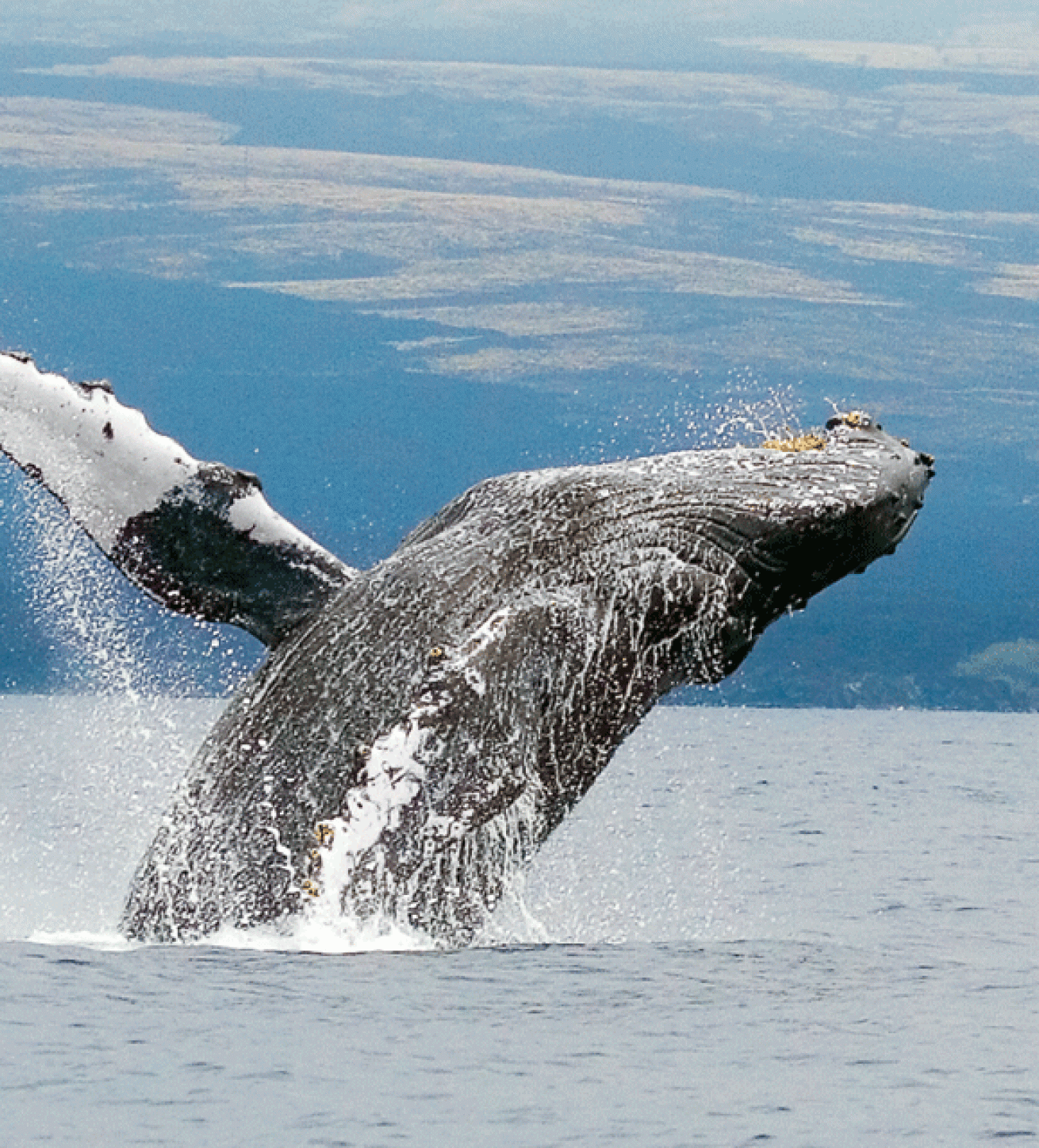
Tim RockHumpbacks and other whales are carefully protected on the Kona Coast.
The excitement is palpable when we come aboard, from the crew as much as the guests. Everywhere around us, as soon as we leave the wharf at Kailua-Kona Village, are humpback whales.
It’s mid-February on the Kona Aggressor II, sailing the sheltered western side of the Big Island of Hawaii. This is the time of year when whales come here to calve and mate — humpback, pilot, beaked, sperm — in an area where they are jealously protected. Boats cannot approach closer than 100 yards. They cannot cut off a calf from its mother. They cannot impede the whales’ movements in any way, or interfere with their heading. They cannot put divers in the water on top of whales.
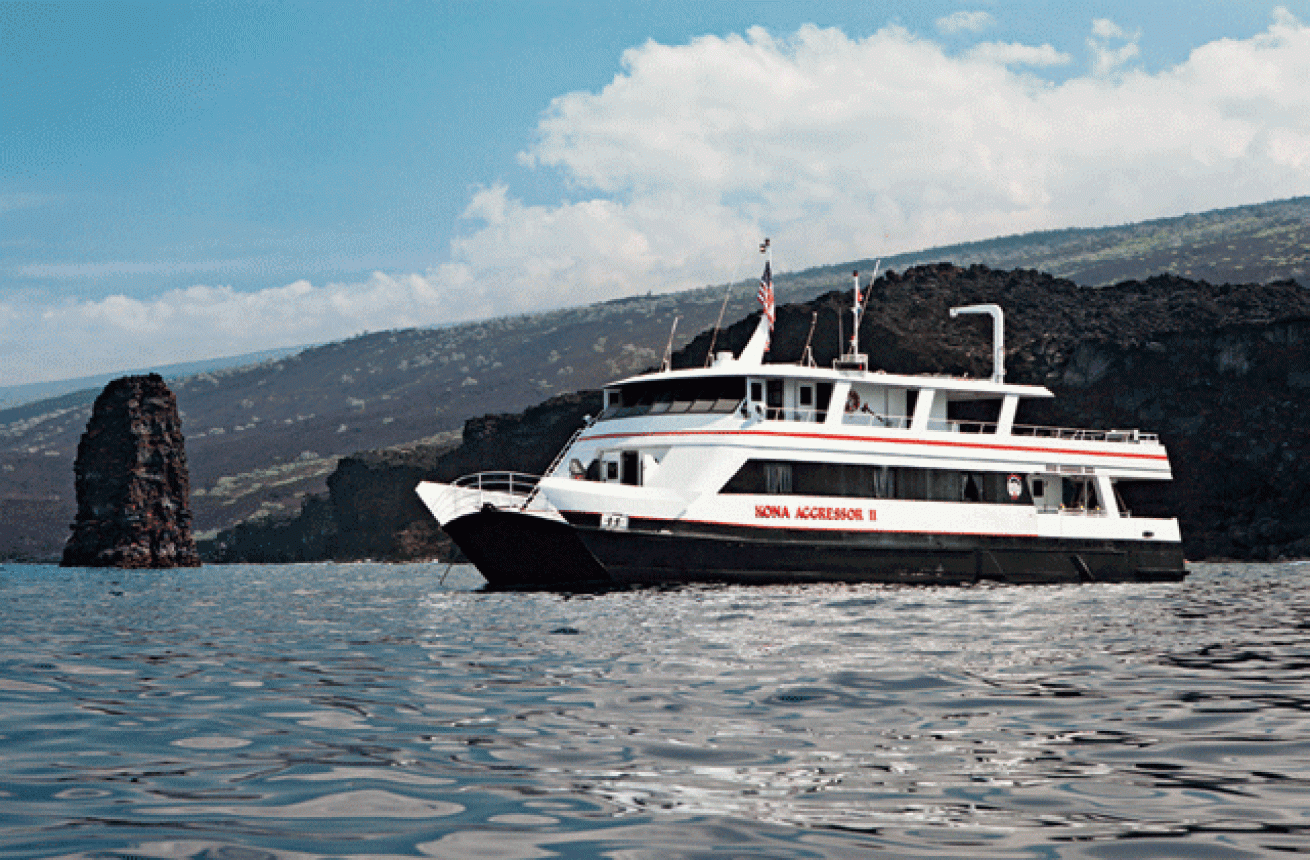
Courtesy Aggressor FleetThe live-aboard Kona Aggressor II.
But you might just get lucky and see one cruise by while you’re underwater. That’s the secret hope of every diver on the Kona Coast.
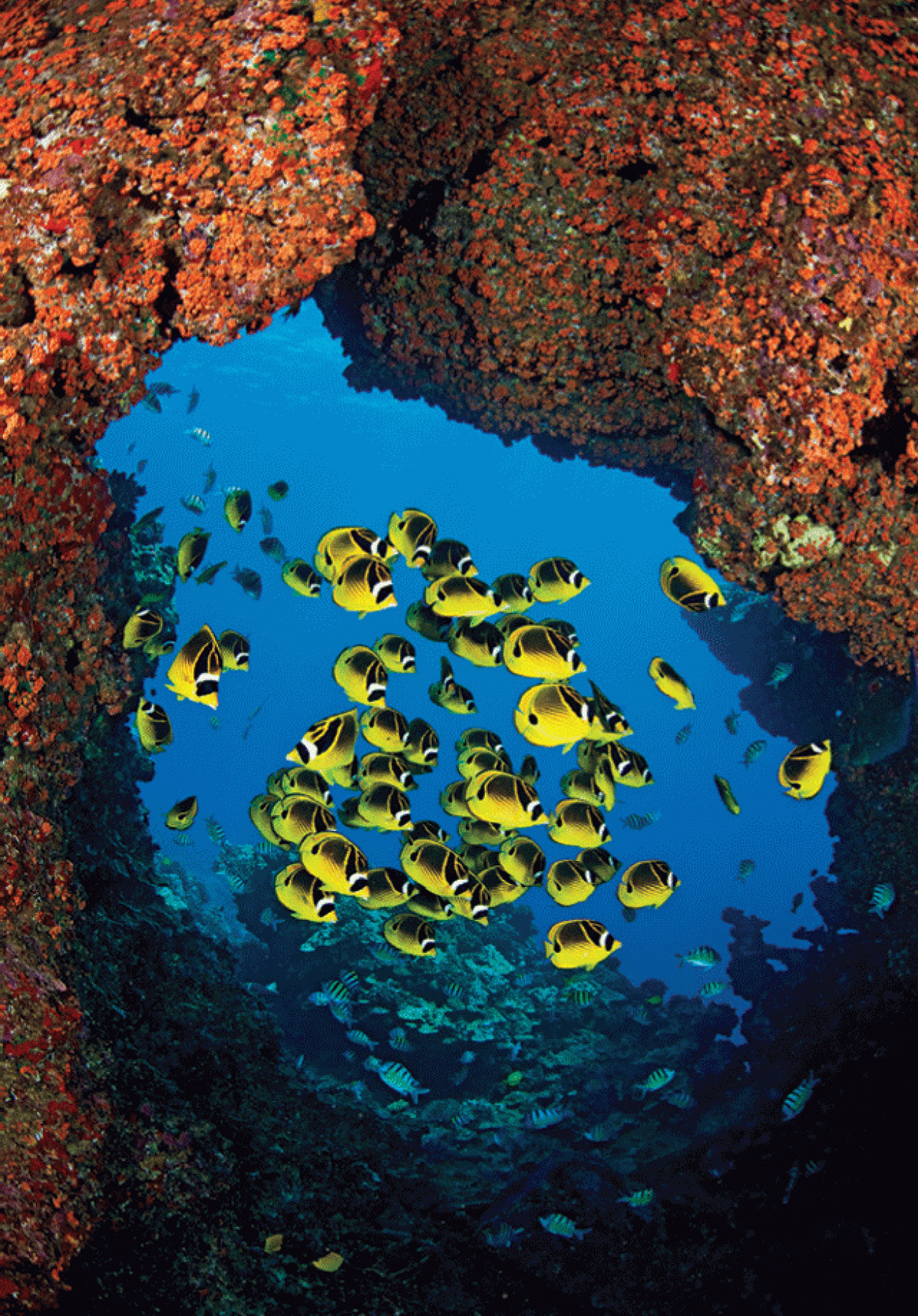
David FleethamKona is land of the butters: Raccoon butterflyfish are just one of dozens of variations.
Our checkout dive is at a site nobody expects to be very special; it’s mostly a chance for the crew to assess skills. But something comes along that makes everybody forget all about the whales: a 10-foot tiger shark — “Shirley” to the divemasters, who recognize her. Meeting a battle-scarred predator face to face will reset your idea of what counts as a shark: This is an animal that commands your full attention. (She didn’t share the feeling, deciding after a quick look that we weren’t worth further investigation.)
Next dive we meander around the same site, until I start hearing a strange squeaky sound in the distance, like squealing rubber. It would drop several registers and sound like a cow, or a wolf, then rise again in pitch, an arpeggio of mournful, beautiful, eerie notes. Every diver rotates slowly in the blue, trying to pinpoint the direction — harder than you’d think underwater. The noises get loud, then louder.
Suddenly our divemaster, Hale Tomasson, 29, is furiously scribbling on his slate. He flips it around: THEY’RE CLOSE.
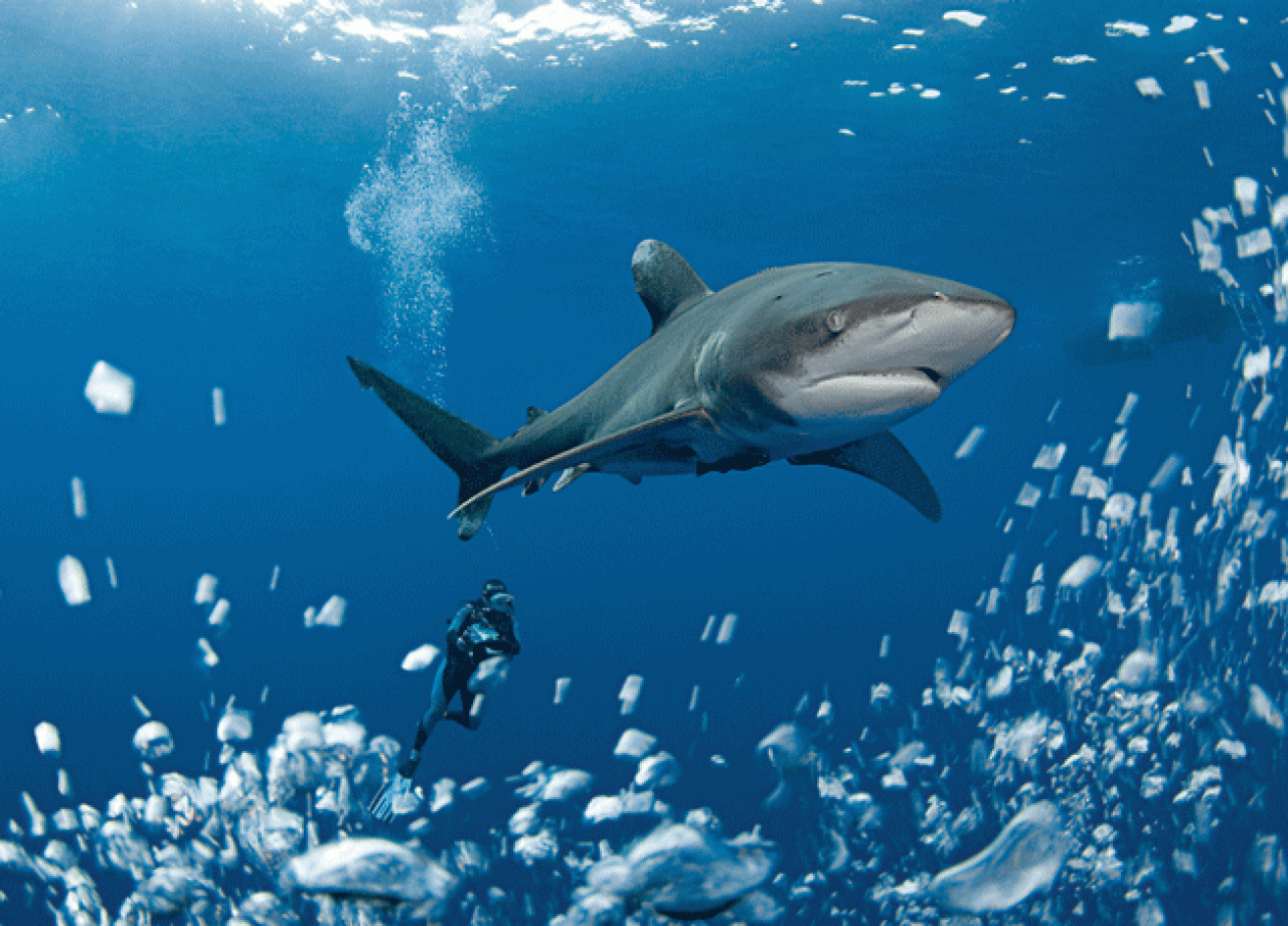
Doug PerrineSharks are not uncommon at sites like Turtle Pinnacle.
Then he takes off finning madly into the blue, with most of us swimming hard behind him. But the calls begin to weaken, and we quickly abandon the quest.
No whales for us today.
We surface a short while later to a dripping crew with strangely guilty looks. There had been whales all right — right under our yacht, in about 50 feet of water. Crew members snorkeled with two until not long before we got back.
It’s that possibility of a new adventure every minute that makes everybody jump up from the dining table and rush the bow, cameras in hand, every time whales are sighted, which is more or less constantly. It must be frustrating for chef Chris Mercier, 34.
While every liveaboard will tell you “our cook is a chef,” on KAII, it’s the truth. (He’s also an avid free diver.) From the first night’s teriyaki-marinated grilled steaks with coconut-infused creamed spinach, to black marlin on risotto with lime beurre blanc, to surface-interval snacks laid out like upscale-resort offerings — fine cheeses, canapés, spiced and sweetened nuts, tapenade, bruschetta, fruit trays — you will eat well and often on KAII.
It’s all part of the liveaboard life, Kona-style.
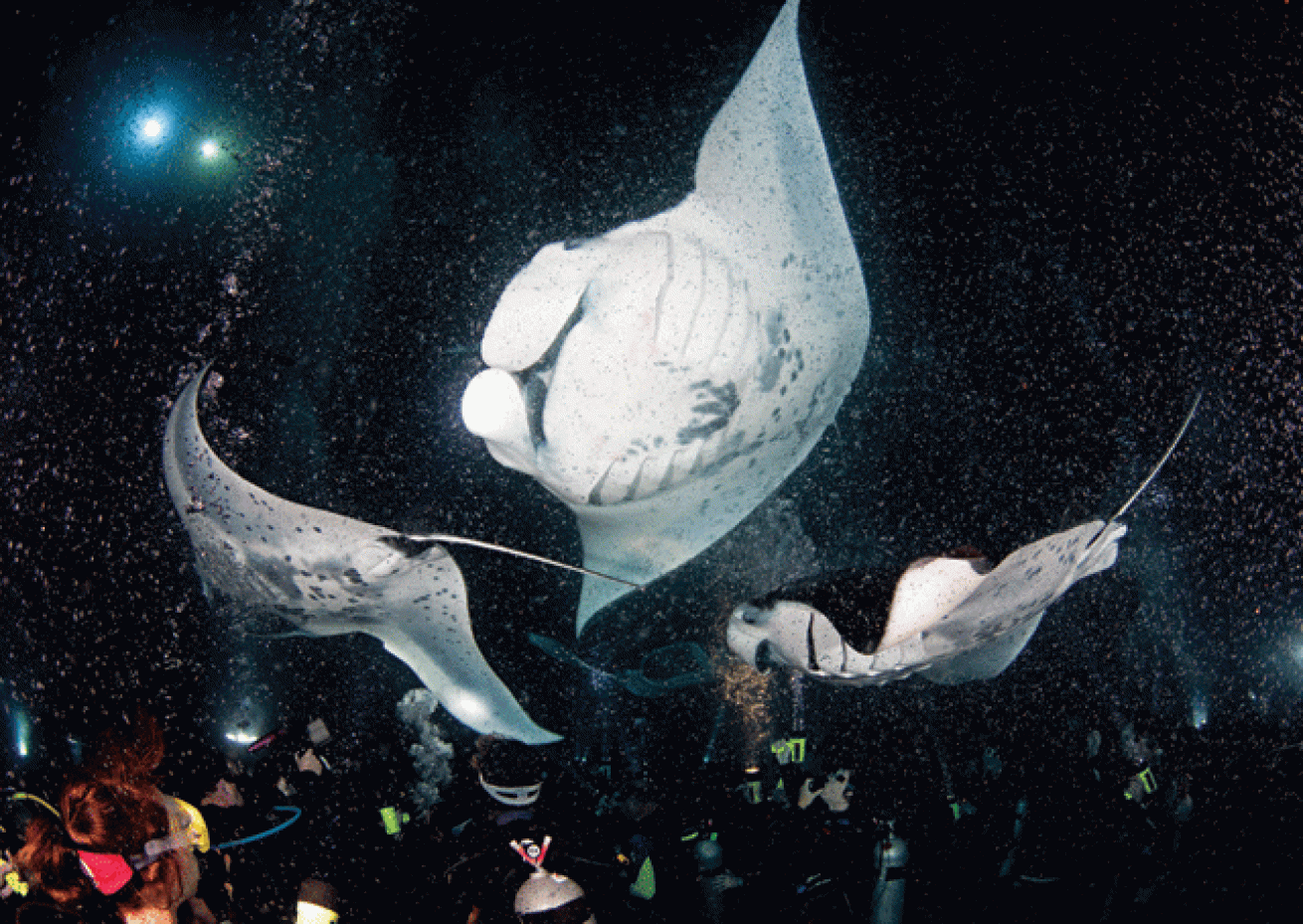
Walt StearnsThe manta night dive is the mother of all Kona dives.
KONA DIVE GUIDE
Reading that Hawaii has nearly 700 fish species — 25 percent of them found nowhere else — is one thing; seeing them is quite another, since you may feel as if you are bumping into several hundred. If you are a fish nut, Hawaii is your tree.
Ellie Briscoe, 62, a dive instructor and retired National Geographic librarian, is taking what I think of as a game and making something important of it. She has brought blank forms and does fish surveys on several dives, noting sightings and numbers of dozens of kinds of butterflyfish, surgeonfish, wrasse and more, results she’ll upload to REEF.org databases on her return home to Alexandria, Virginia — I resolve to take a fish-ID specialty after seeing how much fun Ellie is having. She and husband Mel Briscoe, 72, a dive instructor and oceanographer, are pros who lead trips to Bonaire, the Bahamas, Turks and Caicos, Kona, and elsewhere through Blue Octopus Scuba in Alexandria. They’ve pretty much seen it all but appreciate how thorough KAII’s dive staff is about pointing out fish unique to Hawaii, and to the Kona Coast. “There’s stuff here you will see nowhere else,” Mel says.
Divers actually got possessive of the fish-ID books — KAII carries many — there’s that much to identify for the logbooks. Some divers were practically sleeping with them, memorizing things seen and things hoped for on the next day’s dives — or the next night’s dives.
The mother of all Kona dives is the famed manta night dive, which takes place at Garden Eel Cove and off the Keauhou Sheraton pretty much every evening.
Sixteen boats full of eager divers and snorkelers are arrayed at Garden Eel Cove by nightfall on our first manta night dive. (One major advantage of KAII: We weren’t going anywhere when those boats had to head back.) We enter the water and fin over to a large sandy area where a manta hoedown is in full swing. Dozens of dive lights point to the heavens, Jedi sabers drawing mantas like squadrons of Rebel fighters, diving in and looping back for another go, over and over and over. Swooping, twirling, soaring, standing on their heads — and yours — it’s explosive, a sensory overload. Yet the animals seem completely comfortable with it.
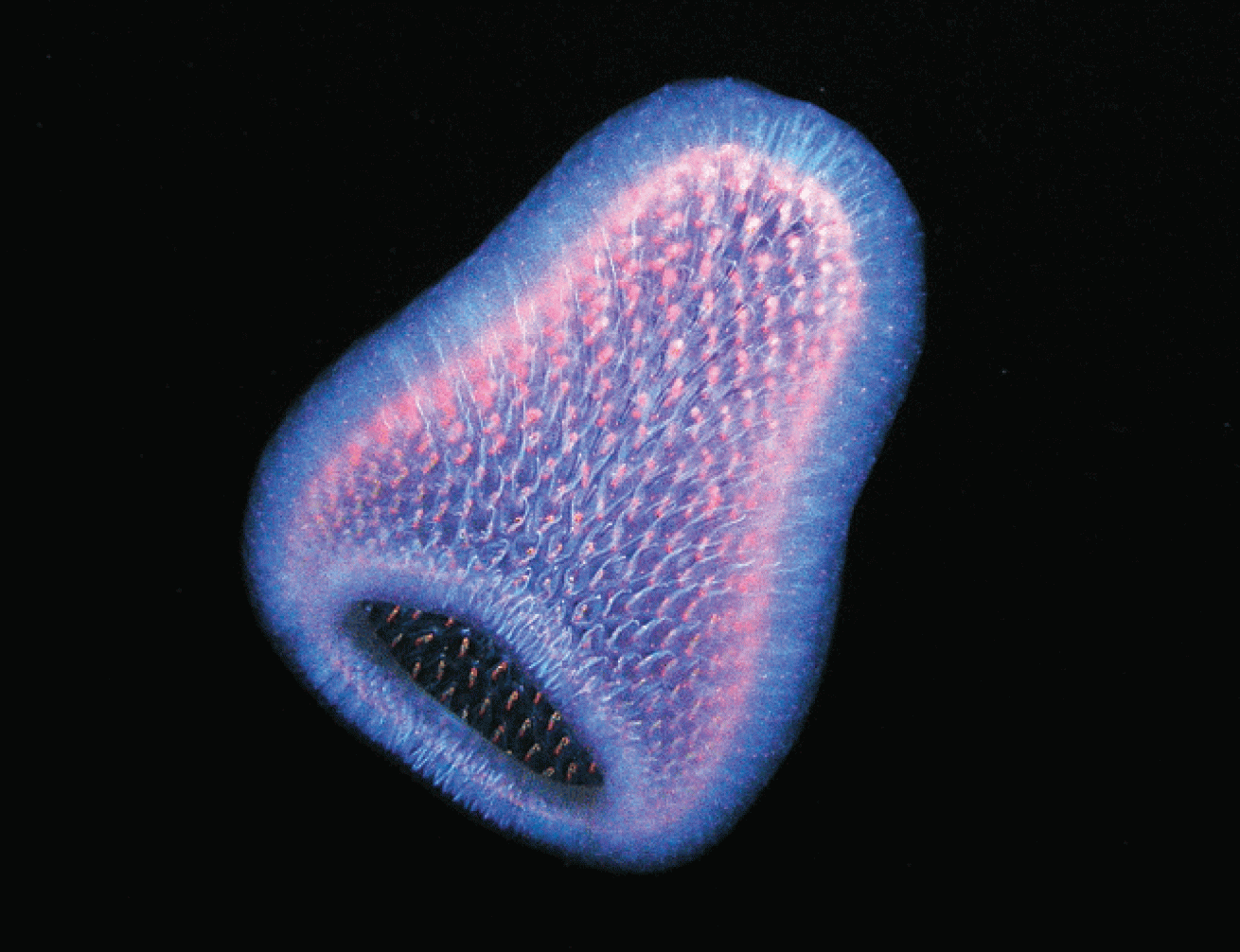
Matthew D'AvellaPyrosomes are free-floating colonial tunicates that are found in shallower, warmer open ocean waters. These cylindrical- or conical-shaped colonies are actually made up of hundreds to thousands of individuals, known as zooids.
“I knew what to expect,” my dive buddy Danny Knoll, 26, shop manager at Beaver Divers in Eagle-Vail, Colorado, said later, “but I was just giggling the whole time. It was magic. I haven’t seen that many mantas, and that was, like, extreme rays.”
The key is the light: The better your light, the more plankton is attracted, and the more manta action for that diver. My Watershot Strkyer video light made me a prime target for sometimes-aggressive manta love-bumps — I felt like a manta sandwich more than once.
After 40 minutes to an hour in the arena, we start back toward KAII, with a few of the 20 mantas following along. A couple did loop-the-loops under Aggressor’s lights for longer than I stayed to watch, a private encore to a spectacular show. “The coolest thing was how they followed us back to the boat,” Knoll said. “To swim with them there, where it wasn’t staged — what a dive!”
It’s hard to believe, but that’s not nearly the freakiest after-dark experience on the Kona Coast. Pelagic Magic — where divers hang of 40-foot lines in 3,000 feet of water and wait in the dark to see what comes up — is not for everybody. Patience is rewarded — little by little, mysteries unfold in the largest animal migration on Earth. First, long tubelike creatures with bulbish “lights,” then jellies — box and other types, streamers trailing — and then the really weird stuff starts rising. Diaphanous animals moving like Tilt-A-Whirls, complete with running lights. Pyrosomes that glow all over. Stupefying, amazing, unbelievable sights — 45 minutes goes by way too fast.
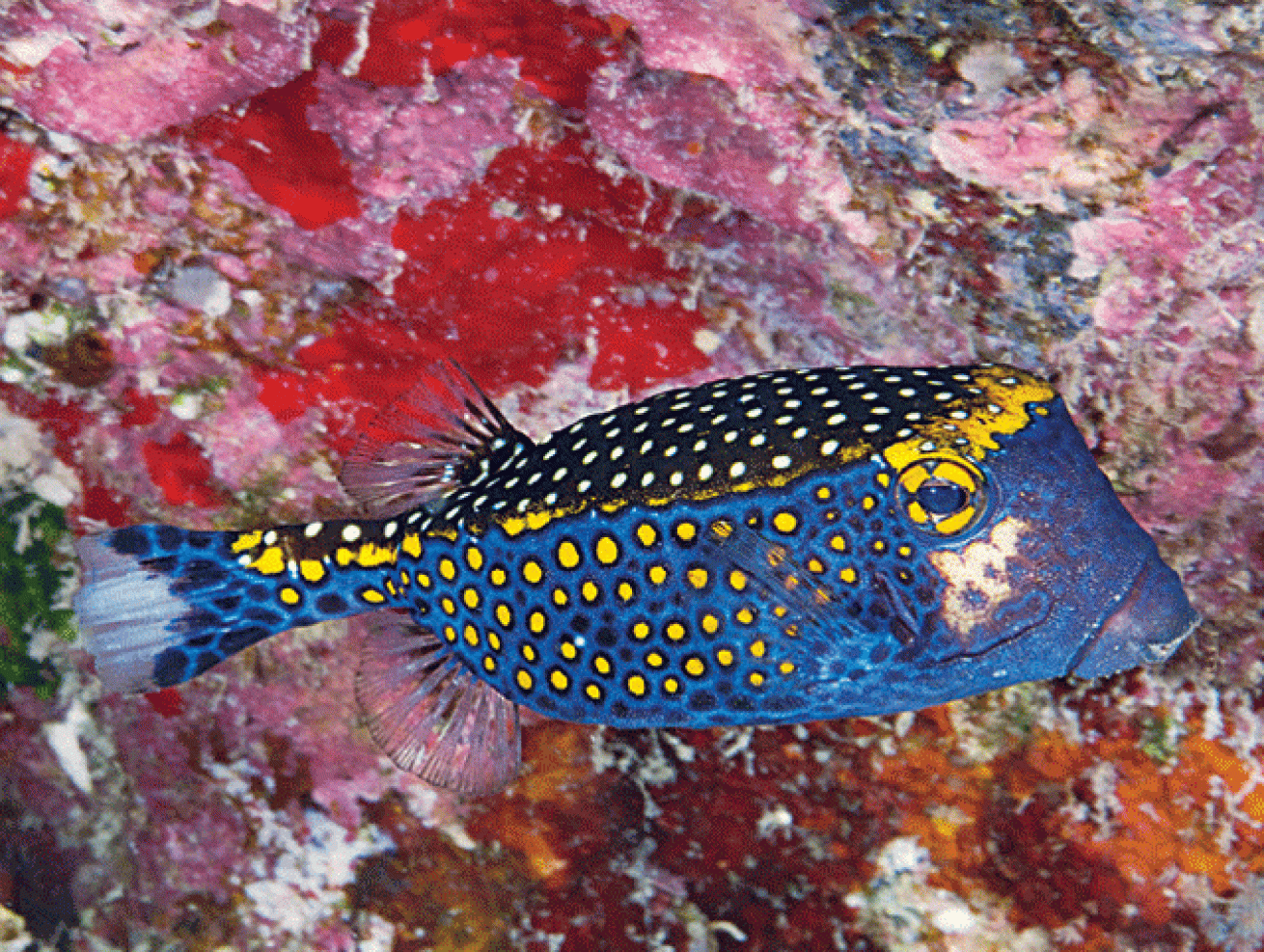
Doug PerrineBoxfish are also called cowfish and trunkfish. Male white-spotted boxfish (Ostracion meleagris) have yellow spots on blue on their sides, while the female is entirely black with white spots.
That drama comes with the territory in Kona. At Au Au Crater, an ancient landslide left an enormous V-shaped bowl in the earth, a reminder that the Big Island is always re-forming itself, even today. It’s hard to comprehend such beauty from a terrible cataclysm, but Au Au — and Kona — is the proof. The steep-sided bowl provides one of Hawaii’s best wall dives, and the top of the crater is home to many of those rare or endemic fish — we spy bandit angelfish and tinker’s butterfly here on two dives.
At other sites — too many to list — we experience another uniquely Hawaiian treat: lava tubes, formed when the out- side of a finger of lava cools faster than what’s moving through it. When the flow ends — voilà! — a tube. And although Kona has virtually no soft coral, the hard corals are spectacularly pretty, from giant lobe corals that form little Hobbiton-like hills to octo, caulifower, rice, finger and more.
On our last dive, we’re practically storming the beach at a site called Old Airport, seemingly just yards from an oceanfront home belonging to Microsoft magnate Paul Allen. (He allegedly offered to build Kailua-Kona a cruise-ship pier, the better to moor his mega-yachts; the village said mahalo, but no thanks.)
As if on cue, the last few animals I had pored over in the ID books magically appear — leather coral, blue goatfish, reticulated angel, and a devil scorpionfish on the move. But once again, invisible whales are stealing the show. Their song is crazy loud, so loud that I can feel it vibrating my chest, somewhere between a flutter and a rumble. Every diver turns toward the open ocean as if drawn by a magnet. Surely they will reveal themselves ....
Of course, they don’t. But I imagine I know what they’re saying: They’re calling us back to Kona, back to the blue. It’s a call I’ll heed, the very next chance I get.
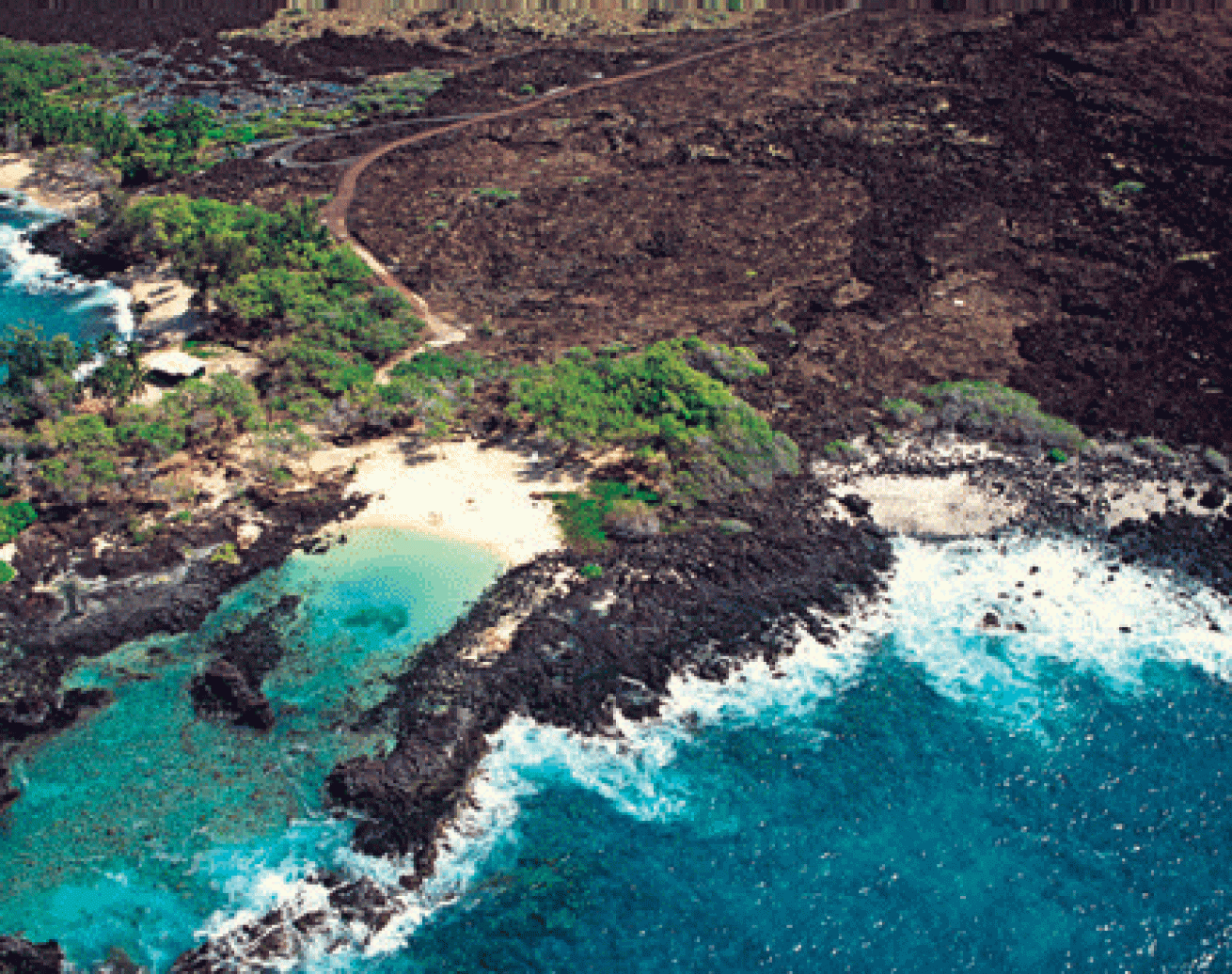
Douglas Peebles PhotographyA helicopter tour in Kailua-Kona Village is worth every penny.
5 REASONS TO CHOOSE KONA AGGRESSOR II
1. “The Cellphone Aggressor:" That’s what other Aggressor crews call KAII because you’re never out of touch if you don’t want to be. Many dives are fewer than 100 yards from shore — perfect for divers who aren’t at liberty to be completely out of communication with home or office.
2. Exotic but close to home: Despite that cellphone, most mainlanders will feel like they’re in a foreign land, but without the hassle of Customs or three days of travel to get there.
3. Kailua-Kona Village: KAII’s home port is a friendly place, with shopping, eating and sightseeing for every taste and budget. A helicopter tour is worth every penny — take the earliest tour of the day to beat the “volcano smog,” steam and smoke that can limit views.
4. Dive, dive dive: You never really dry off on an Aggressor yacht. Although the lounges on KAII’s sun deck sometimes make it hard not to skip a dive.
5. Like nowhere else: From its hundreds of gorgeous endemic species to the manta night dives to Pelagic Magic, Kona offers experiences you can’t find anywhere else. Period.

